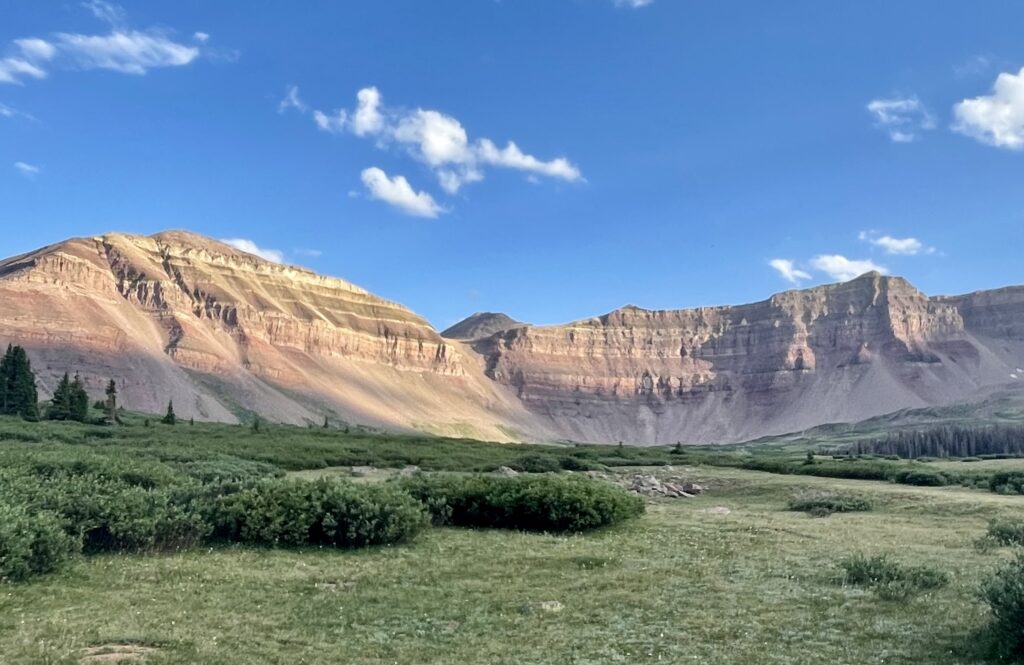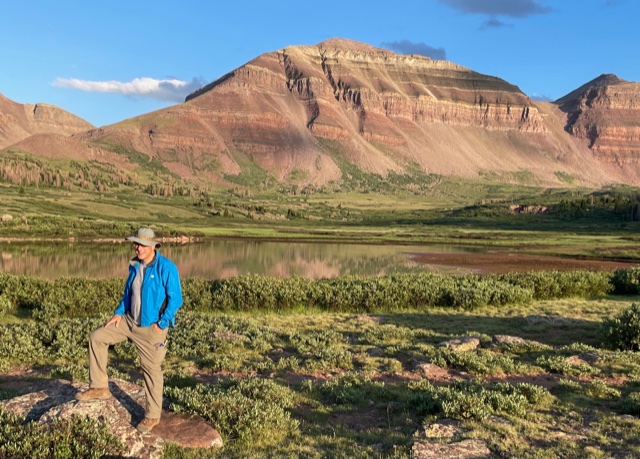
I’ve made the personal commitment to summit the highpoint of each state (except Alaska) and visit every U.S. National Park. In July 2021, my good friend George and I attempted to scale King’s Peak; at 13,528 feet, it’s the summit of Utah. We tacked this adventure on to the end of a week’s visit to Arches and Canyonlands National Parks with Sandy, a mutual friend.
Advance Prep

I watched You-tube videos of individuals doing this as a day hike and realized that person is not me. The hike is nearly 30 miles round-trip with a net elevation gain of over 4,000 feet. George and I aligned on a 3-day backpack adventure, so this became the first of my highpoints that would not be a day hike.
But this is new terrain for me, backpacking. I had experienced some disastrous backpacking in my teens and had sworn off it for years. Fortunately, I also had a few very good experiences as an adult on guided climbing adventures in the Wyoming Tetons and up Kilimanjaro, but that was some years ago. In any event, I didn’t own a tent and wasn’t sure where I’d stashed my large backpack of yesteryear, last used two decades ago in the Tetons. Fortunately, George – who has done his fair share of backpacking and lived to tell about it – agreed to be my jungle guide and show me the ropes.
So, this idea of camping out for two nights in the High Uintas Wilderness as part of a 30-miler up to the roof of Utah was well outside my comfort zone. Day 1, you hike about 8 miles carrying 35 lbs of gear, food, and water on your back to a grassy plateau at 10,800 feet near the foot of the peaks. Day 2, you “go vertical” to the 13,528-foot summit of King’s Peak — about 3,500 vertical feet up and another 3,500 down – and return your tired self back to the tent site, which is hopefully still as you left it. Day 3, you pack everything up and carry it back out those same 8 miles to the trailhead and your car.
In preparation, I researched online and bought the best 2-person tent one could find, an orange beauty named Big Agnes. I found my backpack, sleeping bag and pad, mittens and ski hat – temperatures were expected to range from a high of 70 F down to 40 F. I bought a plastic cup, bowl, and spork. George brought the Jetboil stove and pot, and we bought the fuel and food locally — oatmeal, cocoa, coffee, fruit, and freeze-dried Indian food that ravaged my innards. The list goes on, but for those who don’t do this sort of thing, you start to understand how easy it is to accumulate a lot of transport weight. In hindsight, while I didn’t bring a boombox, I certainly overpacked.
Tip: At 10,000 feet, there are no bears, so no need to hang your foodstuffs which is great. And if you’re in the market for a tent, I enthusiastically recommend my new friend, Agnes.
Day 1: The Approach

It’s a relatively remote trailhead, and we arrived there around noon. Five hours later, we completed the 8-mile trek and arrived at this large, wide-open, grassy meadow just past Dollar Lake. This is the area where most hikers will pitch tents, surrounded on three sides by high peaks – absolutely spectacular. It is a testament to the beauty of the scenery that I didn’t even mind the rainstorm that blew through in the afternoon. We pitched our tent in a stunning location, not far from a running stream, noting four or five other tents scattered about, and I remembered this is The Great of what backpacking is all about. I was tired from the trek and carrying 35 lbs for 8 miles, and wished I had done a bit more advance training. Very glad I brought DEET and a mosquito head net, though thankfully, as sundown approached and the temperature dipped, those little buggers went to bed. And not long thereafter, George and I did, too.
Day 2: Summit Day

The plan was to start by 6:30 am, but we dallied a bit – a gorgeous sunrise! — and didn’t get underway until 7:30 am. We also opted to take the primary trail route and not a “use trail” shortcut. Altogether, that led to us nearing the summit at 11:30 am, which was on track with our plan to be off the summit by 1:00 pm and avoid the common afternoon showers.
Unfortunately, Mother Nature was on a different timetable. We found ourselves caught up in quite a hailstorm as noon approached, with undertones of thunder rumbling in the distance. Over the years, there has been a significant incidence of lightning deaths atop King’s Peak, and we didn’t want to risk becoming part of that statistic. So, at app. 13,300 feet – only 200 vertical feet from the summit, which we could see dead ahead of us – we turned around. A while later, on our descent, we met up with a guide and his client, who had likewise turned around before summitting. George and I felt vindicated in making that tough choice. Within a few hours, the sun had re-emerged, and it felt like an entirely new day. Timing is everything, they say, but not in our favor that day. Anyway, I’ve decided to check this one off the highpoint list for my personal records, but I understand that, technically, we didn’t quite make it. Close enough, in my book.
Tip: As mentioned, there’s a shortcut option which can reduce hiking distance by several miles, albeit via a steeper ascent up a faint path. It also enables one to avoid descending 600 feet and reascending same a few miles later. If I were to do it again, I’d opt for this route.
Day 3: The Hike Out

It was another beautiful morning in the meadow, but I was not at my best on the return hike. Let me spare us the intimate details – and for the record, it wasn’t George’s cooking — but I was experiencing greater discomfort than the normal day-after aches and made a mental note of the various items I was carrying for no good reason. Fortunately, the weather was great, the scenery still stunning, and we even saw moose from a distance. I became excited about future backpacking opportunities!
Reflecting on this adventure, I realized that the joy in it was all about the journey, not the destination. Technically, I didn’t quite make it to the summit, but, for me, that’s a minor footnote. I gained some new skills along with the realization that my older body can’t do as much as that younger body I thought I still occupied. C’est la vie. But I’m finding that by continuing to challenge myself with new experiences outside my comfort zone, I learn and grow and re-experience the joy of new discovery. And to me, that’s what life is all about.

